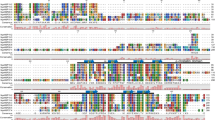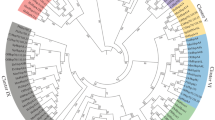Abstract
Cryptomonad algae and Chlorarachiniophyta are evolutionary chimaeras derived from the engulfment of an eukaryotic phototrophic endosymbiont by a eukaryotic host cell. Although much reduced, the endosymbiont's eukaryotic plasmatic compartment still contains a nucleus, the so-called nucleomorph. These nucleomorphs carry the smallest known eukaryotic genomes. We have characterized the genomes of several cryptomonads and a Chlorarachnion species by means of PFGE (pulsed-field gel electrophoresis). Hybridization studies with small subunit rDNA were used to identify the nucleomorph chromosomes. We also performed hybridization experiments with an hsp70 probe to estimate the distribution of this gene among the different algal species. The evolutionary, genetical, and physiological implications of our studies are discussed. A model on the possible function of the nucleomorph hsp70 gene products is presented.
Similar content being viewed by others
References
Dingwall C, Laskey RA (1991) Nuclear targeting sequences—a consensus? Trends Biochem Sci 16:478–481
Dodge JD (1973) The fine structure of algal cells. Academic press, London
Douglas SE, Turner S (1991) Molecular evidence for the origin of plastids from a cyanobacterium-like ancestor. J Mol Evol 33:267–273
Douglas SE, Murphy CA, Spencer DF, Gray MW (1991) Cryptomonad algae are evolutionary chimaeras of two phylogenetically distinct unicellular eukaryotes. Nature 350:148–151
Eschbach S, Hofmann CJB, Maier U-G, Sitte P, Hansmann P (1991) A eukaryotic genome of 660 kb: karyotype of nucleomorph and cell nucleus of the cryptomonad alga, Pyrenomonas salina. Nucleic Acids Res 19:1779–1781
Gething M-J, Sambrook J (1992) Protein folding in the cell. Nature 355:33–45
Gibbs SP (1978) The chloroplast of Euglena may have evolved from symbiotic green algae. Can J Bot 56:2883–2889
Gibbs SP (1979) The route of entry of cytoplasmatically-synthesized proteins into chloroplasts of algae possessing chloroplast ER. J Cell Sci 35:253–266
Gibbs SP (1981) The chloroplast of some algal groups may have evolved from endosymbiotic eukaryotic algae. Ann NY Acad Sci 361:193–208
Gillot MA (1990) Phylum Cryptophyta (Cryptomonads). In: Margulis L, Corliss JO, Melkonian M, Chapman DJ (eds) Handbook of Protoctista. Jones and Barlett Publishers, Boston, USA, pp 139–151
Gray MW (1992) The endosymbiont hypothesis revisited. Int Rev Cytol 141:233–357
Greenwood AD, Griffiths HB, Santore UJ (1977) Chloroplasts and cell compartments in Cryptophyceae. Br Phycol J 12:119
Guillard RRL (1975) In: Smith WL, Chanley MH (eds) Culture of marine invertebrate animals. pp 29–60
Hansmann P (1988) Ultrastructural localization of RNA in Cryptomonads. Protoplasma 146:81–88
Hansmann P, Falk H, Sitte P (1985) DNA in the nucleomorph of Cryptomonas demonstrated by DAPI fluorescence. Z Naturforsch 40c:933–935
Hibberd DJ (1990) Phylum Chlorarachnida. In: Margulis L, Corliss JO, Melkonian M, Chapman DJ (eds) Handbook of Protoctista. Jones and Barlett Publishers, Boston, USA, pp 288–291
Hofmann CJB, Rensing SA, Häuber MM, Martin WF, Müller SB, Couch J, McFadden GI, Igloi GL, Maier U-G (1994) Smallest known eukaryotic genomes encode a protein gene: towards an understanding of nucleomorph functions. Mol Gen Genet 243:600–604
Maerz M, Wolters J, Hofmann CJB, Sitte P, Maier U-G (1992) Plastid DNA from Pyrenomonas salina (Cryptophyceae): physical map, genes, and evolutionary implications. Curr Genet 21:73–81
Maier U-G (1992) The four genomes of the alga Pyrenomonas salina (Cryptophyta). BioSystems 28:69–73
Maier U-G, Hofmann CJB, Eschbach S, Wolters J, Igloi GL (1991) Demonstration of nucleomorph-encoded eukaryotic small subunit RNA in Cryptomonads. Mol Gen Genet 230:155–160
Margulis L (1970) Origin of eukaryotic cells. University Press, New Haven, Connecticut
McFadden GI (1990) Evidence that cryptomonad chloroplasts evolved from photosynthetic eukaryotic endosymbionts. J Cell Sci 95:303–308
McFadden GI (1990) Second-hand chloroplasts: evolution of cryptomonad algae. Adv Bot Res 19:190–239
McFadden GI, Gilson PR, Hofmann CJB, Adcock GJ, Maier U-G (1994a) Evidence that an amoeba acquired a chloroplast by retaining part of an engulfed eukaryotic alga. Proc Natl Acad Sci USA 91:3960–3964
McFadden GI, Gibson PR, Douglas S.E. (1994b) The photosynthetic endosymbiont in cryptomonad cells produces both chloroplast and cytoplasmic-type ribosomes. J Cell Sci 107:649–657
Rensing SA, Maier U-G (1994) Phylogenetic analysis of the stress-70 protein family. J Mol Evol (in press)
Sitte P (1993) Symbiogenetic evolution of complex cells and complex plastids. Eur J Protistol 29:131–143
Tomas RN, Cox ER (1973) Observations on the symbiosis of Peridinium balticum and its intracellular alga. J Phycol 9:304–323
Valentin K, Cattolico RA, Zetsche K (1993) Phylogenetic origin of the plastids. In: Lewin RA (ed) Origins of plastids. Chapman and Hall, New York London
Vollrath D, Davis RW (1987) Resolution of DNA molecules greater than 5 megabases by contour-shaped homogeneous electric fields. Nucleic Acids Res 15:7865–7876
Author information
Authors and Affiliations
Additional information
Communicated by H. Kössel
This paper is dedicated to Prof. Dr. Peter Sitte on the occasion of his 65th birthday
Rights and permissions
About this article
Cite this article
Rensing, S.A., Goddemeier, M., Hofmann, C.J.B. et al. The presence of a nucleomorph hsp70 gene is a common feature of Cryptophyta and Chlorarachniophyta. Curr Genet 26, 451–455 (1994). https://doi.org/10.1007/BF00309933
Received:
Issue Date:
DOI: https://doi.org/10.1007/BF00309933




